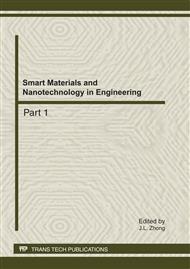[1]
S. Li. Ecology of the terrestrial alga Nostoc flagelliforme Berk. et Curt. in China Journal of Applied Phycology, 1991, 27(Suppl): 45.
Google Scholar
[2]
K. Gao. Chinese studies on the edible blue-green alga, Nostoc flagelliforme. Journal of Applied Phycology, 1998 10: 37–49.
Google Scholar
[3]
K. Kanekiyo, et al, Isolation of an antiviral polysaccharide, Nostoflan, from a terrestrial cyanobacterium, Nostoc flagelliforme J. Nat. Prod, 2005, 68: 1037-1041.
DOI: 10.1021/np050056c
Google Scholar
[4]
S. Jia, H. Yu, Y. Lin, Y. Dai. Characterization of Exocellular Polysaccharide of Nostoc flagelliforme in Liquid Suspension Culture Biotchnology and Bioprocess Engineering, 2007, 12(3): 271−275.
DOI: 10.1007/bf02931103
Google Scholar
[5]
Z. Dai. Review of Nostoc flagelliforme research, Journal of Ningxia University (Natural Sciences) , 1992, 13(1): 71–76 (in Chinese with English abstract).
Google Scholar
[6]
J. Su, Q. He, S. Jia. Photosynthetic and Respiratory Rates in Liquid Suspension Culture Cells of Nostoc flagelliforme Born. Et Flah, Plant Phycology Communications, 2006, 42(3): 417-420(in Chinese with English abstract).
Google Scholar
[7]
J. Su, S. Jia, X. Chen, H. Yu. Morphology, cell growth, and polysaccharide production of Nostoc flagelliforme in liquid suspension culture at different agitation rates, Journal of Applied Phycology, 2008, 20: 213–217.
DOI: 10.1007/s10811-007-9221-4
Google Scholar
[8]
H. Yu, S. Jia, Y. Dai. Growth characteristics of the cyanobacterium Nostoc flagelliforme in photoautotrophic , mixotrophic and heterotrophic cultivation, Journal of Applied Phycology , 2009, 21: 127–133.
DOI: 10.1007/s10811-008-9341-5
Google Scholar
[9]
S. Jia, H. Yu, Y. Lin, Y. Dai. Characterization of Exocellular Polysaccharide of Nostoc flagelliforme in Liquid Suspension Culture Biotchnology and Bioprocess Engineering, 2007, 12(3): 271−275.
DOI: 10.1007/bf02931103
Google Scholar
[10]
X. Liu, S. Wang, M. Xie. Effects of polysaccharide from Cyclocarya paliurus (Batal. ) on growth of HeLa cells and human umbilical vein endothelial cells, Food Science, 2007, 28: 520-522( in Chinese with English abstract).
Google Scholar
[11]
Y. Dong, T. Fen, Z. Zhang, J.X. Mu. Nutrient Composition Analysis of Spiral Algae, Food Research and Development, 2003, 24(3): 70-71(in Chinese with English abstract).
Google Scholar
[12]
Z. Hu, Z. L. Determination and purification of β-carotene in Spirulina Maximum, Chinese Journal of Chromatography. 2001, 19: 85-87( in Chinese with English abstract).
Google Scholar
[13]
Y. Chen, R. Zhang, Q. Hu. Rapid determination of β-carotene in fresh fruits and vegetables, Food Science, 2008, 29, 406-407 (in Chinese with English abstract).
Google Scholar
[14]
FAO/WHO. Energy and protein requirements: Report of a joint FAO/WHO ad hoc expert committee. FAO Nutrition Meetings Re port Series No. 52. WHO Technical Report Series No. 522. 1973. Rome and Geneva.
DOI: 10.1002/food.19740180314
Google Scholar
[15]
V. Dembitsky, T. Rezanka. Metabolites produced by nitrogen-fixing Nostoc species Folia Microbiol, 2005, 50: 363–391.
DOI: 10.1007/bf02931419
Google Scholar


